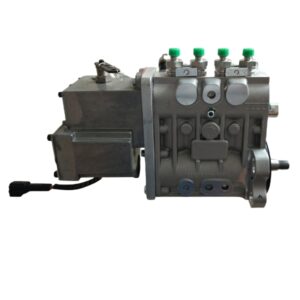The Cummins 4BT engine is celebrated for its rugged durability, but like any mechanical system, it can develop problems over time. Whether you’re dealing with rough idling, power loss, or unusual noises, diagnosing issues early can save you time and money. In this guide, we’ll walk you through proven methods to troubleshoot Cummins 4BT engine problems, identify common failures, and implement solutions.

1. Recognize Common Cummins 4BT Engine Symptoms
Start by observing the engine’s behavior. Key symptoms often hint at underlying issues:
- Hard Starting or No Start: Could indicate fuel delivery problems, glow plug failures, or low compression.
- Loss of Power: May stem from turbocharger issues, clogged filters, or injector malfunctions.
- Excessive Smoke:
- Black Smoke: Suggests incomplete combustion (dirty air filter, faulty injectors).
- White Smoke: Often caused by coolant leaks or unburned fuel.
- Blue Smoke: Signals oil burning (worn piston rings or valve seals).
- Unusual Noises: Knocking, rattling, or whining could point to bearing wear, timing gear problems, or turbo failure.
2. Gather Essential Diagnostic Tools
Equip yourself with the right tools for accurate troubleshooting:
- OBD-I Scanner: While the 4BT predates modern OBD-II systems, basic code readers can help identify sensor issues.
- Compression Tester: Critical for checking cylinder health.
- Fuel Pressure Gauge: Detects leaks or weak fuel pumps.
- Multimeter: Tests electrical components (glow plugs, sensors).
- Mechanical Stethoscope: Pinpoints abnormal noises in specific engine areas.
3. Step-by-Step Diagnostic Process
A. Check Fuel System Issues
- Inspect Fuel Filters: Clogged filters restrict fuel flow, causing power loss or stalling. Replace them if dirty.
- Test Fuel Pressure: Low pressure may indicate a failing lift pump or air leaks in the fuel lines.
- Examine Injectors: Remove and test injectors for proper spray patterns. Dirty or stuck injectors cause misfires.
Keyword Tip: Include phrases like “Cummins 4BT fuel system troubleshooting” or “4BT injector problems.”
B. Evaluate Air Intake and Turbocharger
- Air Filter Inspection: A dirty filter reduces airflow, leading to black smoke and poor performance.
- Turbocharger Check: Look for shaft play, oil leaks, or damaged blades. Whining noises often signal turbo failure.
- Boost Pressure Test: Use a boost gauge to ensure the turbo delivers adequate pressure (typically 10–15 PSI for stock 4BTs).
Keyword Tip: Target “Cummins 4BT turbo problems” or “4BT boost pressure test.”
C. Test Compression and Cylinder Health
- Warm Up the Engine: Ensure accurate readings by testing at operating temperature.
- Perform a Compression Test: Healthy 4BT cylinders should read 350–400 PSI. Variations over 10% between cylinders suggest worn rings, valves, or head gasket issues.
- Inspect Glow Plugs: Faulty glow plugs cause hard starts in cold weather. Test resistance with a multimeter.
Keyword Tip: Search “Cummins 4BT compression test” or “4BT cylinder compression specs.”
D. Inspect Cooling and Oil Systems
- Coolant Leaks: Check for visible leaks around the radiator, water pump, or head gasket. Overheating often warps the cylinder head.
- Oil Analysis: Discolored or milky oil indicates coolant contamination (blown head gasket). Low oil pressure may warn of worn bearings or a failing oil pump.
4. Address Electrical and Sensor Failures
Though mechanically simple, the 4BT relies on critical electrical components:
- Throttle Position Sensor (TPS): A faulty TPS can cause erratic idle or throttle response.
- Engine Speed Sensor: Failure may lead to no-start conditions or inaccurate tachometer readings.
- Wiring Harness: Corroded or frayed wires disrupt sensor signals. Inspect connections for corrosion.
5. Investigate Unusual Noises
- Knocking or Rattling:
- Upper Engine: Worn valve train components or loose rocker arms.
- Lower Engine: Connecting rod or main bearing failure.
- Whining or Whistling: Often linked to turbocharger or belt-driven components (e.g., alternator, water pump).
- Clicking: Could indicate stuck injectors or low fuel pressure.
6. Preventative Maintenance to Avoid Future Issues
- Regular Oil Changes: Use 15W-40 diesel-grade oil and replace filters every 200–300 hours.
- Fuel System Cleanliness: Add fuel additives to prevent injector clogs and water contamination.
- Coolant Flushes: Replace coolant every two years to prevent corrosion and overheating.
- Belt and Hose Inspections: Check for cracks or wear to avoid sudden failures.
7. When to Seek Professional Help
While many issues can be DIY-diagnosed, consult a certified Cummins technician for:
- Persistent low compression despite repairs.
- Internal engine damage (e.g., cracked block, bent rods).
- Complex electrical or ECM-related faults.
Final Thoughts
Diagnosing Cummins 4BT engine problems requires methodical observation, testing, and familiarity with its mechanical systems. By addressing symptoms early and performing routine maintenance, you can extend the life of this legendary diesel engine. Always prioritize safety—disconnect the battery before repairs and consult service manuals for torque specs and procedures.